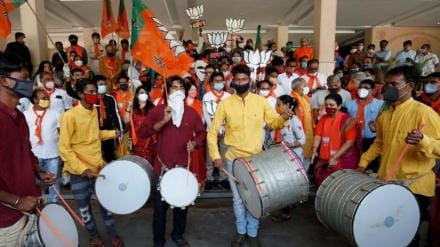Bihar Election 2025: As the Election Commission of India (ECI) has announced the schedule for the Bihar Legislative Assembly elections, a recent opinion poll by IANS-Matrize News Communications has stirred the political landscape, projecting a commanding lead for the National Democratic Alliance (NDA) with 49 per cent vote share and 150-160 seats in the 243-member assembly.
The survey, titled “Bihar Vidhan Sabha Chunav Opinion Poll-2025,” positions the ruling NDA, led by Chief Minister Nitish Kumar’s JD-U and the Bharatiya Janata Party (BJP), as the frontrunner, indicating a potential consolidation of power amid ongoing debates on unemployment, migration, and governance.
Who will win in Bihar elections?
According to the IANS-Matrize poll, the NDA’s projected vote share marks a significant jump from the 37.3 per cent it secured in the 2020 elections, where it narrowly clinched victory despite a near-tie in popular votes with the opposition.
The BJP is expected to lead the pack within the alliance with 21 per cent votes and 80-85 seats, reflecting its growing organisational strength in the state.
JD-U follows closely at 18 per cent votes and 60-65 seats, underscoring Nitish Kumar’s enduring appeal among certain voter segments despite his frequent alliance shifts, the survey said. Smaller partners like Hindustani Awam Morcha (HAM) at 2 per cent (3-6 seats), Lok Janshakti Party (Ram Vilas) (LJP(R)) at 6 per cent (4-6 seats), and Rashtriya Lok Morcha (RLM) at 2 per cent (1-2 seats) contribute to the coalition’s robust total.
On the opposition front, the Indi Alliance (formerly Mahagathbandhan) is forecasted to secure 36 per cent votes and 70-85 seats, a slight dip from its 37.2 per cent in 2020.
The Rashtriya Janata Dal (RJD), under Tejashwi Yadav, remains the alliance’s powerhouse with 21 per cent votes and 60-65 seats, positioning it as a “direct challenger” to the NDA’s dominance, the survey said.
The Indian National Congress (INC) is pegged at 8 per cent (7-10 seats), while left-leaning parties like the Communist Party of India (Marxist-Leninist) Liberation (CPI(ML)L) at 4 per cent (6-9 seats), CPI at 1 per cent (0-1 seats), and CPI(M) at 1 per cent (0-1 seats) add ideological depth.
The Vikassheel Insaan Party (VIP), which was part of the NDA in 2020, has shifted to the INDIA Bloc, projected at 1 per cent (2-4 seats). The All India Majlis-e-Ittehadul Muslimeen (AIMIM) is expected to garner 1 per cent votes and 1-3 seats, targeting minority voters in Seemanchal regions.
New party in the fray
A standout is the Jan Suraaj Party, founded by political strategist Prashant Kishor, forecasted at 7 per cent votes and 2-5 seats. Other parties, including the Bahujan Samaj Party (BSP) and Jharkhand Mukti Morcha (JMM), are lumped together at 7 per cent votes and 7-10 seats, indicating potential kingmaker roles in a hung assembly scenario.
The IANS-Matrize poll’s data reveals a polarised electorate, with the NDA benefiting from perceived stability under Nitish Kumar, who has been CM for multiple terms since 2005, barring brief interruptions. However, critics point to his alliance flip-flops, most recently re-joining the NDA in January 2024, as a vulnerability.
In contrast, Tejashwi’s 2020 performance, where the Mahagathbandhan lost by a razor-thin margin of about 16,825 votes across key seats, has energised the opposition.
Prashant Kishor’s Jan Suraaj, launched in 2022, aims to disrupt traditional caste-based politics, drawing from his past successes in strategising for parties like the BJP and JD-U.
Bihar’s elections are often decided by complex caste arithmetic, with communities like Yadavs (RJD’s base), Kurmis (JD-U’s core), and EBCs (Extremely Backward Classes) playing pivotal roles. The poll survey suggests the NDA’s broader coalition is paying dividends, but issues like joblessness – Bihar has one of India’s highest unemployment rates – and migration could sway undecided voters.
With the assembly term ending on November 29, 2025, campaigns are in full swing, featuring high-profile rallies by national leaders like Prime Minister Narendra Modi and Leader of the Opposition in Lok Sabha Rahul Gandhi.
Experts caution that opinion polls are snapshots, not guarantees. The 2020 elections saw the NDA win 125 seats against the Mahagathbandhan’s 110, despite near-equal vote shares.
If IANS-Matrize’s predictions hold, the NDA could secure a comfortable majority, potentially installing Nitish for another term or paving the way for a BJP-led government.
As Bihar braces for what promises to be a high-stakes battle, the focus remains on development promises versus identity politics.
Voters, numbering over 70 million, will decide if the state continues with the NDA’s “double engine” growth model or shifts toward the opposition’s welfare-centric agenda.
With the ECI’s announcement, the electoral machinery is set to roll, marking another chapter in Bihar’s vibrant democratic saga.
